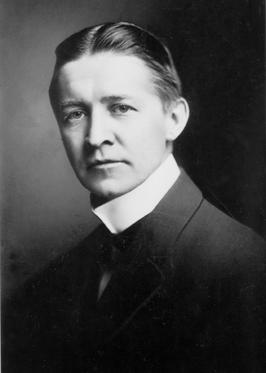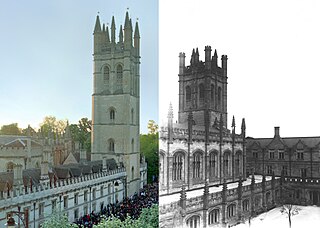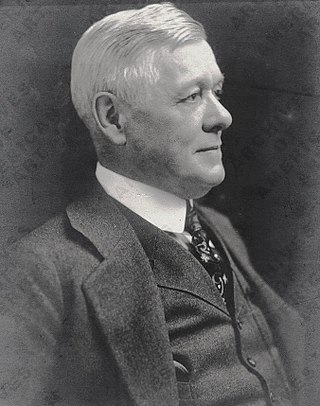Related Research Articles

Ralph Adams Cram was a prolific and influential American architect of collegiate and ecclesiastical buildings, often in the Gothic Revival style. Cram & Ferguson and Cram, Goodhue & Ferguson are partnerships in which he worked. Cram was a fellow of the American Institute of Architects.

Bertram Grosvenor Goodhue was an American architect celebrated for his work in Gothic Revival and Spanish Colonial Revival design. He also designed notable typefaces, including Cheltenham and Merrymount for the Merrymount Press. Later in life, Goodhue freed his architectural style with works like El Fureidis in Montecito, California, one of three estates he designed.
Adolph Alexander Weinman was a German-born American sculptor and architectural sculptor.

Karl Theodore Francis Bitter was an Austrian-born American sculptor best known for his architectural sculpture, memorials and residential work.

Graduate School of Architecture, Planning and Preservation (GSAPP) is the architecture school of Columbia University, a private research university in New York City. It is regarded as an important and prestigious architecture school. It is also home to the Masters of Science program in Advanced Architectural Design, Historic Preservation, Real Estate Development, Urban Design, and Urban Planning.

Collegiate Gothic is an architectural style subgenre of Gothic Revival architecture, popular in the late-19th and early-20th centuries for college and high school buildings in the United States and Canada, and to a certain extent Europe. A form of historicist architecture, it took its inspiration from English Tudor and Gothic buildings. It has returned in the 21st century in the form of prominent new buildings at schools and universities including Cornell, Princeton, Vanderbilt, Washington University, and Yale.

Carrère and Hastings, the firm of John Merven Carrère and Thomas Hastings, was one of the outstanding American Beaux-Arts architecture firms. Located in New York City, the firm practiced from 1885 until 1929, although Carrère died in an automobile accident in 1911.

Vertner Woodson Tandy was an American architect. He was one of the seven founders of Alpha Phi Alpha fraternity at Cornell University in 1906. He was the first African American registered architect in New York State. Tandy served as the first treasurer of the Alpha chapter and the designer of the fraternity pin. The fraternity became incorporated under his auspices.

John Galen Howard was an American architect and educator who began his career in New York before moving to California. He was the principal architect at several firms in both states and employed Julia Morgan early in her architectural career.
Wallace Augustus Rayfield (1874–1941), was an American architect and educator. He was the second formally educated practicing African American architect in the United States.

John Massey Rhind was a Scottish-American sculptor. Among Rhind's better known works is the marble statue of Dr. Crawford W. Long located in the National Statuary Hall Collection in Washington D.C. (1926).

St. Philip's Episcopal Church is a historic Episcopal church located at 204 West 134th Street, between Adam Clayton Powell Jr. Boulevard and Frederick Douglass Boulevard in the Harlem neighborhood of Manhattan, New York City. Its congregation was founded in 1809 by free African Americans worshiping at Trinity Church, Wall Street as the Free African Church of St. Philip. First located in the notorious Five Points neighborhood, it is the oldest black Episcopal parish in New York City. Historically, it was extremely influential both while located in lower Manhattan and as an institution in Harlem, and many of its members have been leaders in the black community. In 2020, it reported 188 members, 111 average attendance, and plate and pledge income of $224,827.
George Washington Foster Jr., was an American architect. He was among the first African-American architects licensed by the State of New Jersey in 1908, and later New York (1916). Foster partnered with Vertner Woodson Tandy (1885–1949), the first African-American architect licensed by the State of New York, in the firm of Tandy and Foster, which was active from 1908 to 1914.
Robert J. Reiley, AIA, (1878–1961) was an American architect practicing in New York City in the early and mid twentieth century. He was particularly known as a designer of Catholic churches, schools, and hospitals in the Northeast USA.

Ethel Bailey Furman was an American architect who was the earliest known African-American female architect in Virginia.

John B. Sutcliffe was an English-born American architect.
African-American architects are those in the architectural profession who are African American in the United States. Their work in the more distant past was often overlooked or outright erased from the historical records due to the racist social dynamics at play in the country, but the black members of the profession—and their historic contributions—have become somewhat more recognized since.
Ermelindo Eduardo Ardolino, known as Edward Ardolino was an Italian-born American stone carver and architectural sculptor of the early twentieth century. He was the most prominent member of the Ardolino family of stone carvers. He worked with leading architects and sculptors, including architect Bertram Grosvenor Goodhue and sculptor Lee Lawrie. Ardolino participated in at least nine Goodhue-Lawrie collaborations including the Los Angeles Public Library and the Nebraska State Capitol. His carvings adorn a significant number of important public and private buildings and monuments, including four buildings in the Federal Triangle of Washington, D.C.
Matthew W. Del Gaudio was an American architect. He primarily designed churches, apartment buildings, and public housing in New York City.

Eaton W. Tarbell (1914–1992) was an American architect. A student of Walter Gropius, he is best known for introducing International Style architecture to Maine.
References
- ↑ T. Robins Brown, Schuyler Warmflash, Jim DelGiudice, The architecture of Bergen County, New Jersey: the colonial period to the twentieth century
- ↑ Wilson, Dreck Spurlock (2004). African-American Architects: A Biographical Dictionary, 1865-1945. ISBN 978-0-415-92959-2.
- ↑ St Philip's Church History Archived 2010-08-01 at the Wayback Machine (Accessed 2 August 2010)